
Neopolyporolithon reclinatum
Coralline Disc
6 July 2024
Harling Point, Juan de Fuca Strait, Vancouver Island, B.C., Canada
Tide: 0.3 feet at 10:28am PDT (measured at Oak Bay Tidal Station)
Weather: Clear skies, light variable winds (0-10 km/hour), sea smooth, humidity 66%, 17 ˚C.
Moon: Waxing Crescent (0.8%, 1 day); Next Phase, First Quarter, 13 July 2024 at 3:48 pm PDT; Previous Phase, New Moon, 5 July 2024 at 3:57 pm PDT.
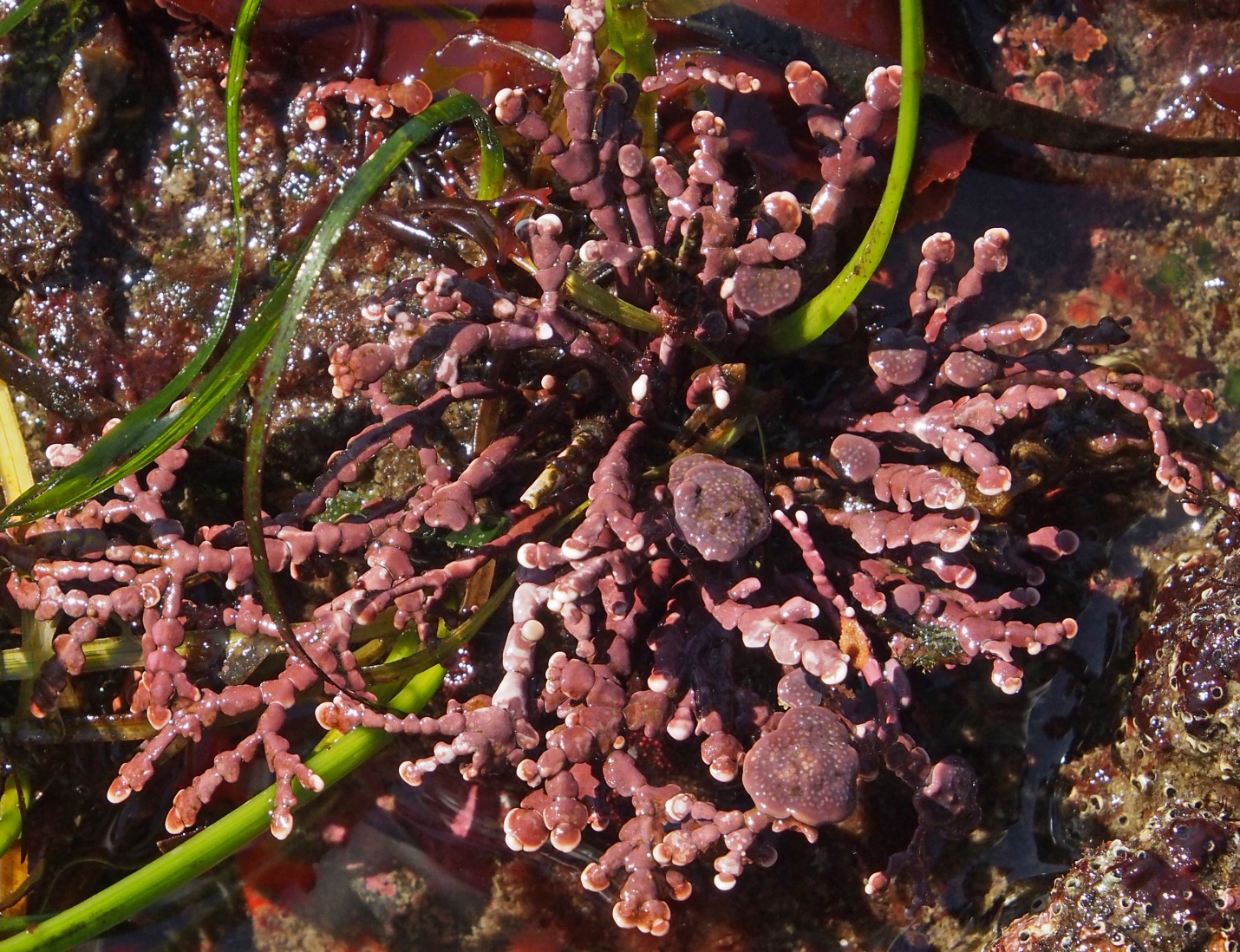
Figure 1: The branched pink ‘bead-coral’ algae in this photo is hosting another calcareous seaweed – the epiphytic Coralline Disc algae, Neopolyporolithon reclinatum. It is the flattish, roundish, more lilac-pink or grey-pink colored seaweed viewed here. Possibly neither algae is what most people think of as “seaweed” but they are members of the red macroalgae group, phylum Rhodophyta. There are actually at least ten of the Coralline Discs in this photo with the smallest only 2 mm in diameter and the largest barely 10 mm. Harling Point, Juan de Fuca Strait, Vancouver Island, British Columbia, Canada. July 6, 2024. Photo ID 27703 ©Seaweedwhisperings.com
Person 1:
We visited Harling Point at low tide, the morning of July 5th. It was calm, with just a few waves from ship wake. We didn’t intentionally interact with any seaweeds that morning.
In the afternoon, Person 2 excitedly exclaimed that upon looking at her pictures, she had photographed several Coralline Discs on an articulated coralline, Calliarthron tuberculosum.
Over the evening and early the next morning, July 6th, I began reflecting on the qualities of Coralline Disc. My reflections resulted in the following notes.
One. Delicate balance, perched atop C. tuberculosum, barely hanging on, going for a wild gleeful ride.
Two. Not much self reflection, just living in the moment.
We visited the Harling Point seashore once again, hoping to interact with N. reclinatum.
Other than ship wake there was a distinct lazy feel about the day..., sunny, calm seas. A flock of Oyster Catchers foraged and loafed only 5 to 20 meters from us and a group of moulting gulls simply sat around nearby, preening and resting, apparently unperturbed by our presence.
The species name ‘reclinatum’ of Coralline Disc seemed very appropriate for the feeling of the day, as well as the laid out flat appearance of this seaweed.
The color of Coralline Disc embraces various tones of greyish pink, contrasting with the pale pink coloration of its host (C. tuberculosum).
I rubbed my fingers over the top of several discs. They had a fine sandpaper roughness to them, contrasting with the smoothness of their host.
We spent quite a bit of time trying to photograph this seaweed. It was quite challenging. Person 2 said afterwards, “I spent most of the time balancing on the cliff edge.” This certainly matched my first impressions of “delicate balance” and “barely hanging on”.
I noticed that my writing today is much more prosaic than usual.
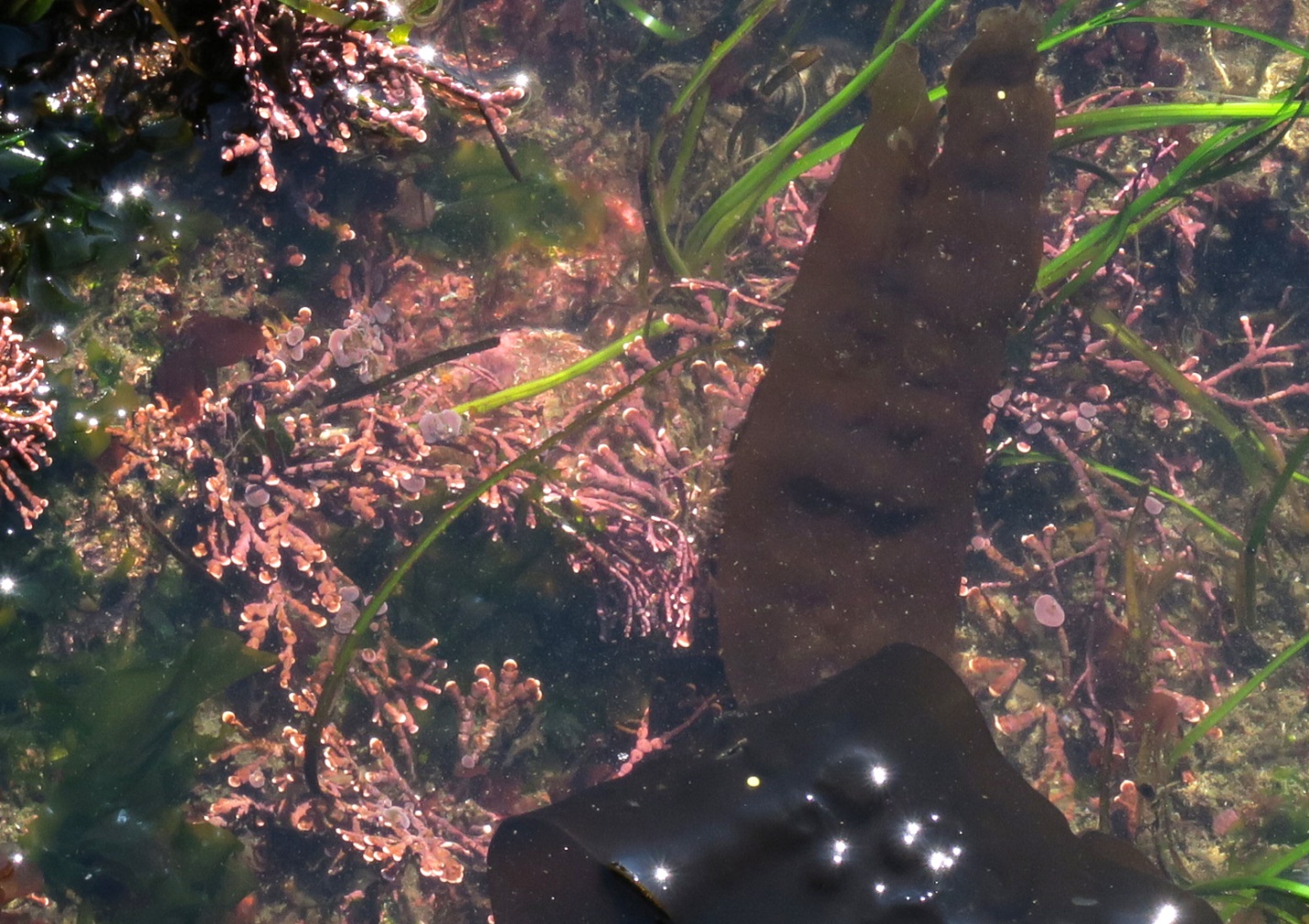
Figure 2: The pink-colored articulated coralline algae here that is immersed and partly hidden by a large brown kelp blade is hosting numerous Neopolyporlithon reticulatum – Coralline Disc individuals. The flat and round disc-algae look light lilac in color compared to the host’s purer pink branches. If you count carefully you’ll find over twenty in this photograph with the very largest measuring no more than 1.3 centimeters in diameter. Harling Point, Juan de Fuca Strait, Vancouver Island, British Columbia, Canada. July 6, 2024. Photo ID 27704 ©Seaweedwhisperings.com
Person 2:
I’ve been looking for this seaweed for quite some time, and yesterday after returning from a low tide outing at Harling Point, I reviewed some photographs. While photographing a nice find – Odonthalia washingtoniensis growing in situ rather than cast ashore, I had also unintentionally photographed some healthy bright pink articulated coralline algae, Calliarthron tuberculosum (Coarse Bead-Coral Algae) and there, resting on the upper surfaces of the coralline branches, I spotted a few rounded, pinky grey discs. These are Neopolyporolithon reclinatum!
I was delighted to find them – even though I only knew it after the fact. Person 1 and I quickly formulated a plan to return at today’s low tide to see if we could explore this seaweed a bit more. The predicted low tide was to be very similar, only 0.1 foot higher, so if the sea remained calm we had a good chance.
The discs seem to have ‘landed’ atop their host coralline algae and found themselves such a comfortable spot that they choose to linger awhile – nicely anchored and free to relax and enjoy the ride as the ocean swells lift and drop, lift and drop, lift and drop the host seaweed.
The Calliarthron tuberculosum is growing here at about the zero foot tide line and lower, and it is on a small rock ledge that drops off quickly and can only be reached by crossing a sloping bedrock intertidal zone that is covered in barnacles, Ulva and Pyropia and other slippery macro algae. In other words, to get close to where these little discs of coralline algae like to live is not so easy for humans. This is in contrast to how relaxed and comfortable Neopoloyporolithon reclinatum seems to be itself! However, curiosity and the desire to learn more is a good motivator and we found a way to get somewhat close and not do much harm to nearby life or ourselves in the process.
In fact, the species name, ‘reclinatum’ quite obviously has me think of reclining..., or a recliner chair..., so lying back and enjoying an easy position of rest while doing not very much at all! This seems to be Coralline Disc’s way to live life!
Sound simple? Well, why not!
And even the shape, a flattened disc that expands in diameter but not thickness, well, it’s a simple circular shape. And it quite rightly orients itself in positions that face up to the sunlight. It is an earthy coralline ‘sea disc’ facing up to the golden disc that is our universe’s fiery star, the sun.
At one point today I had the idea to photograph our macro algae with a ruler alongside – I was curious as to the actual sizes of our Coralline Disc individuals and its host’s branch sizes, too. Just as I got the idea and retrieved my ruler ready for photography, wake swells arrived that swamped the area which had been until then nicely just above the water line. I had the thought, “Oh, Neopolyporolithon doesn’t want to be measured!” This could be linked to a few things.
Are they conscious of their size and sensitive about it?
Are they not accustomed to being measured in physical ways?
Do they prefer to commune with the sun and moon, and don’t really care so much about earthly measures at all?
Are they somehow beyond measure?
One thing felt certain to me, I had the sense that the wake swell was giving us a clue by blocking our efforts to be too physical or too analytical in ‘recording’ this little macro algae.
The touch of the algae, even when wet, is like chalky rock – a smooth surface but one that is finely porous, too. The little discs did not feel flexible but are in fact quite rigid and hold their shape with ease.
While not perfectly circular, the disc shape is a good description. Some of the shapes become a bit irregular, but the edges of the discs are more lightly colored – perhaps this is where growth happens, something different goes on at the margins..., on the edges.
Most of them have little round lighter colored dots scattered over their surface. Fancifully I thought of them as mirroring the sky, the sun and the little dots being more distant stars. It is interesting, I really am inclined to think beyond the earth with this little seaweed – another surprise.
Even though this seaweed is associated with only a few hosts, while interacting with Coralline Disc today I felt no idea that Neopolyporolithon reclinatum and C. tuberculosum were “a pair”. I felt no curiosity, at this time, to explore the energy of Calliarthron tuberculosum, simultaneously or as a duo. In other words, it was very easy to focus on Coralline Disc; it comfortably stands alone.
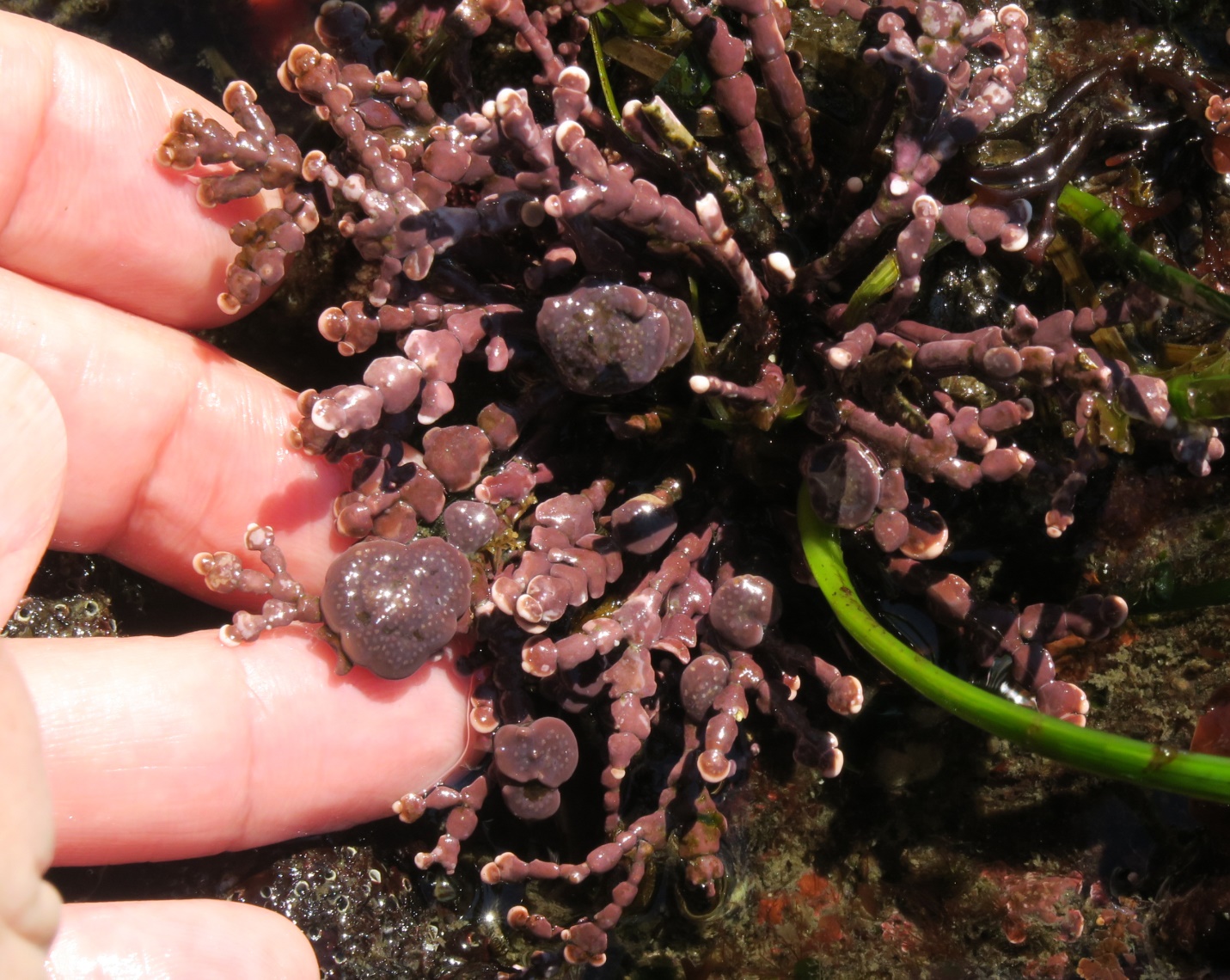
Figure 3: Another view of this rather unusual seaweed. It is calcareous and indeed feels chalky or rough and porous, even when wet. Harling Point, Juan de Fuca Strait, Vancouver Island, British Columbia, Canada. July 6, 2024. Photo ID 27705 ©Seaweedwhisperings.com
Discussion:
The disc shape is like flying saucers, and in the case of Neopolyporolithon reclinatum, they are flying saucers that are content to stay a while in this new spot where they have landed. The look of these algal discs is like the classic flat bottomed, slightly domed, circular shape that is how some iconic intergalactic space ships have been portrayed.
Coralline Disc is an aptly descriptive name but it’s not very exciting. Possibly its scientific name, Neopoloyporlithon reclinatum, compensates.
Coralline Disc seaweed also reminds us of certain fungi that play a role in decomposing wood. But this likeness is not so very strong; it is more that there aren’t many seaweeds that lean that direction at all. Some members of the Ralfsia genus much more strongly have this fungus ‘look’.
The “wild gleeful ride” Person 1 first observed was a rare glimpse at what is typically a more reserved pleasure and understated humor in Coralline Disc. They enjoy themselves, but it’s not outwardly flamboyant or noticeable to others.
The dots on the surface of Coralline Disc seem to reach a suitable spacing while not being strictly arranged or patterned, and there’s no overcrowding of dots. In fact this adds to the overall feel of this seaweed that it is both simply and admirably put together. We felt no striving on the part of Neopolyprolithon reclinatum to receive any admiration from others, but we felt quite compelled to offer it. This feeling is stronger with the seaweed in situ than it is from looking at the photographs. Perhaps it is what Person 1 said, that we were on “the edge” to be able to interact in this seaweed’s habitat, but the seaweed itself felt admirably balanced and comfortably at home there.
It seems rather fanciful to think of the stars and constellations when contemplating a tiny disc of calcareous algae, but this is exactly the kind of span of realities that this seaweed’s energy engendered. Earthly chalk to fiery balls of gas burning in the night sky – no small span at all.
It is interesting that our first ‘sighting’ of this algae was only registered “after the fact” by reviewing photographs aimed at recording other things. Isn’t that also like the gap of time that exists in perceiving the light of the stars? Indeed, how many light years away are they? And is it not true that such intergalactic light that we observe on earth has traveled so far through space that it reflects a history but not a present reality. In human terms, the scale of time and distance is immeasurable and incomprehensible. In this little seaweed is there the capacity to glimpse that ‘gap’ or to simply embrace it with a comfortable awareness? Indeed, we sense that just might be true.
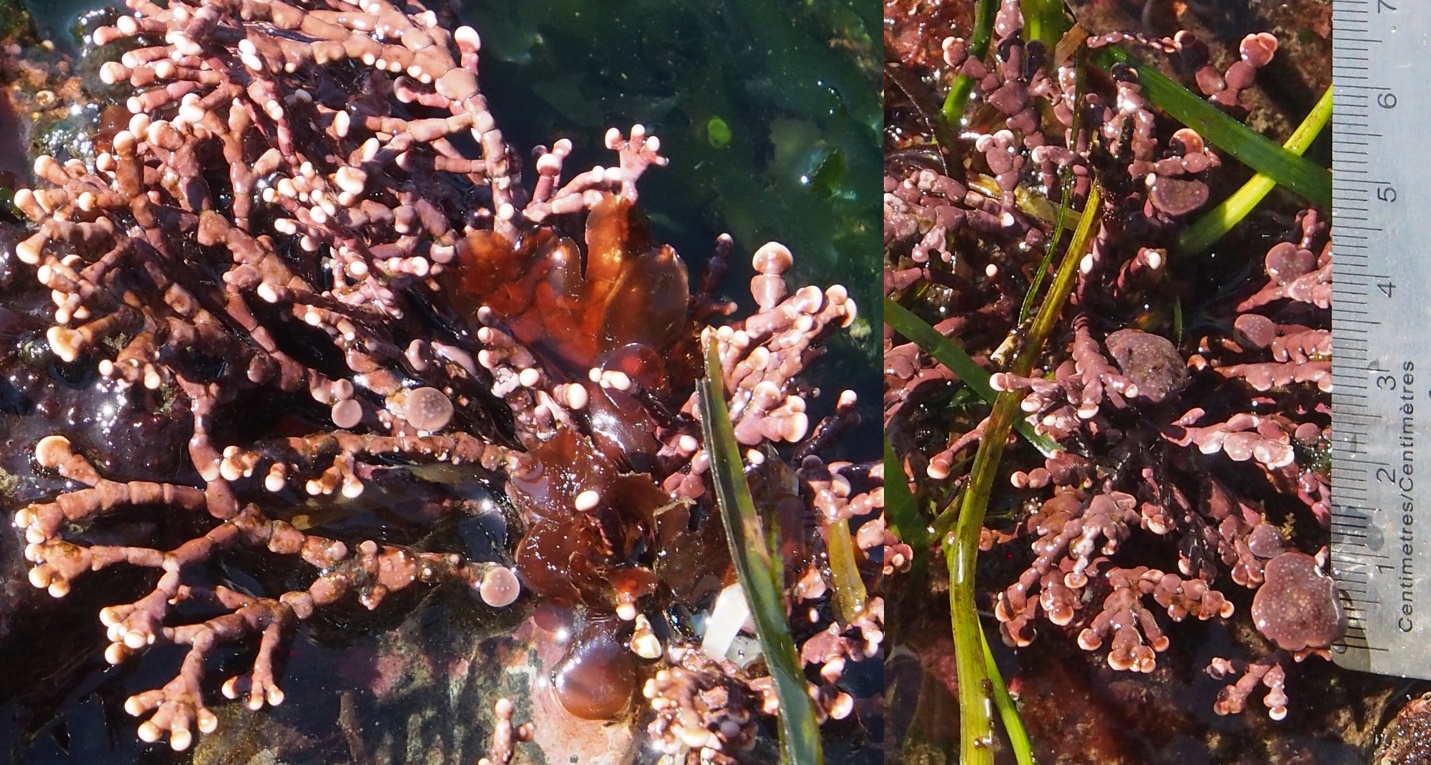
Figure 4: The photo on the left shows an articulated coralline alga with several very small Coralline Discs – they are located on the lower portions of the thalli. The largest one here is 3 mm in diameter and two others are half that size but already the full thickness of more mature individuals. The dots on the surface, while irregularly patterned, seem to not become overcrowded; there is, it would seem, an ideal number relative to the surface area of the disc. On the right, a ruler shows the size of the seaweeds we are observing. Harling Point, Juan de Fuca Strait, Vancouver Island, British Columbia, Canada. July 6, 2024. Photo ID 27706 ©Seaweedwhisperings.com
Biology & Natural History Information:
Description:
A calcareous epiphyte usually found on articulated coralline algae and Ahnfeltia spp., this brownish-pink to lavender-pink discoidal crust is 1.5 cm (0.6 in) diameter and up to 1 mm (0.04 in) thick. It attaches to the host with small pads of tissue (rather than a stipe) at its center, leaving its margins free. Some observers find this seaweed to be reminiscent of wood-rotting fungi by virtue of the flattened circular form and patterning of pores.
Habitat:
This species is commonly found attached to host algae in tide pools and the low intertidal to shallow subtidal zones of semi-exposed to exposed habitats.
North Pacific Distribution:
Aleutian Islands, Alaska, to southern California; Japan; Russia.
Remarks:
Holotype locality: “Botany Beach”, Port Renfrew, Vancouver Island, British Columbia, Canada; (Adey & al. 2015: 198). K. Yendo noted that the holotype of this species was found “between tide marks” on the articulated coralline algae, Cheilosporum frondescens (now called Bossiella frondescens) which was growing on a saltwater clam of the genus Mya.
Classification:
Phylum: Rhodophyta
Class: Florideophyceae
Order: Hapalidiales
Family: Hapalidiaceae
Genus: Neopolyporolithon
Species: Neopolyporolithon reclinatum (Foslie) W.H.Adey & H.W.Johansen 1972
Former name(s) & Synonyms: Basionym: Lithothamnion conchatum f. reclinatum Foslie. Homotypic synonyms: Lithothamnion conchatum f. reclinatum Foslie 1906; Lithothamnion reclinatum (Foslie) Foslie 1907; Polyporolithon reclinatum (Foslie) L.R.Mason 1953; Calthromorphum reclinatum W.H.Adey 1970.
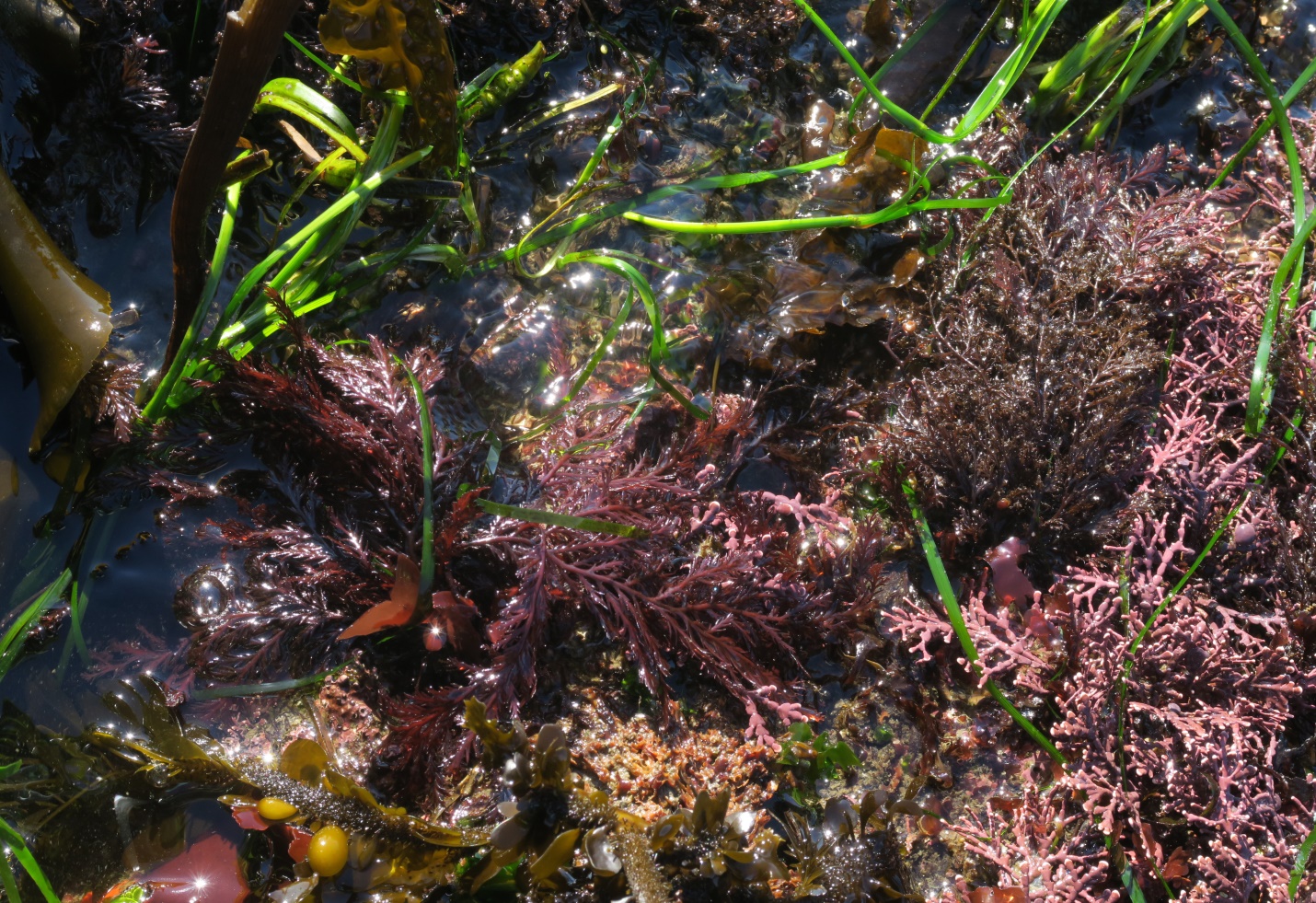
Figure 5: This photograph shows the mix of macro algae that were growing on the bedrock ledge at Harling Point. The sea has just retreated below the top of this area at a 0.2 foot low tide and exposed to view are Odonthalia washingtoniensis (rich red ‘cedar’ branch looking algae), Odonthalia floccosa (dark brown finely branched), and Calliarthron tuberculosum (light pink articulated coralline). Sea grass is also growing and the blades of Egregia menziesii and other large kelps are resting here until the tide returns. Along with the previously named species, this ledge is a suitable habitat for the Neopolyporolithon reclinatum – the Coralline Discs, as it is situated on the open shores of Juan de Fuca Strait and directly exposed to the currents that flow strongly there. Harling Point, Juan de Fuca Strait, Vancouver Island, British Columbia, Canada. July 5, 2024. Photo ID 27707 ©Seaweedwhisperings.com
![]()